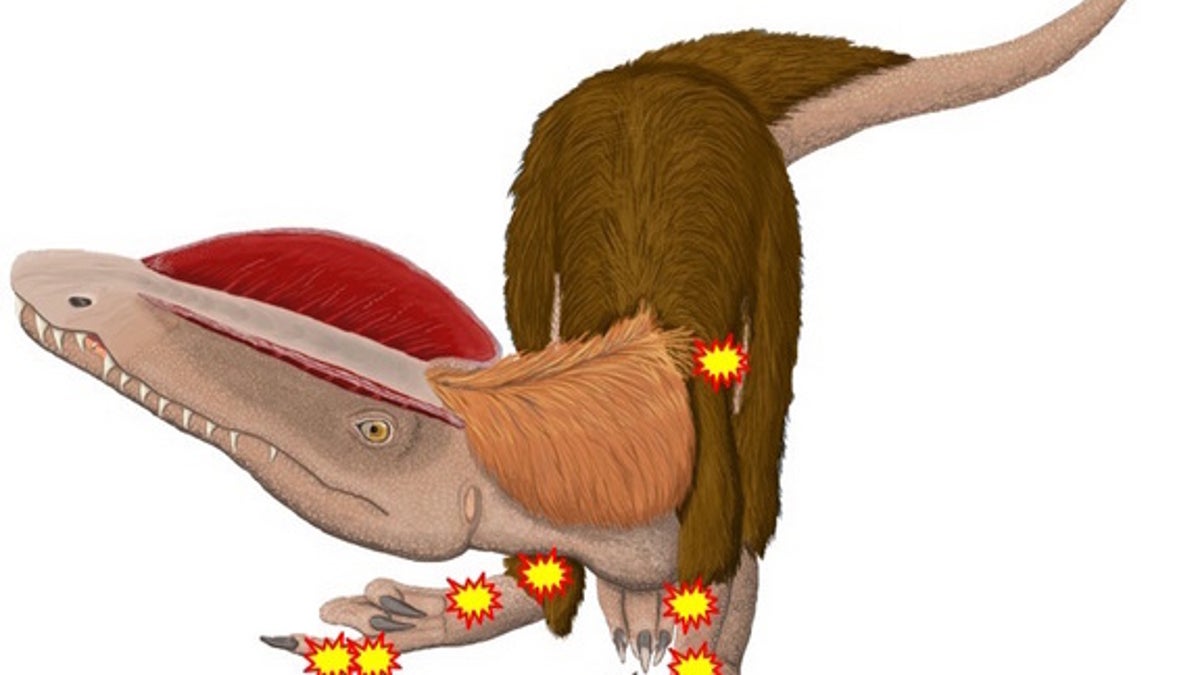
The meat-eating dinosaur Dilophosaurus wetherilli has eight major injuries (indicated by the stars), twice as many as Sue, the Tyrannosaurus rex at the Field Museum in Natural History in Chicago. (Leandra Walters)
A Jurassic-age dinosaur suffered from eight devastating maladies during its lifetime that likely caused the paleo-beast an enormous amount of pain and possibly made it difficult to hunt, a new study suggests.
The beast set a record for most upper-body injuries ever seen on a theropod dinosaur (a group of bipedal, mostly meat-eating dinosaurs), the researchers said. The previous record-holder is Sue, the famous Tyrannosaurus rex on display at the Field Museum of Natural History in Chicago, who has a total of four bone injuries on its shoulder and forelimbs.
"We not only exceeded the record [for theropod injuries], we doubled it," said study co-author Phil Senter, a professor of biology at Fayetteville State University in North Carolina. [Photos: Dinosaur's Battle Wounds Preserved in Tyrannosaur Skull]
Researchers excavated the maimed dinosaur in Arizona in 1942, but nobody analyzed its injuries until recently. The first studies on the dinosaur simply identified its species (Dilophosaurus wetherilli), Senter said. The adult dinosaur measured about 20 feet (6 meters) long, and was found in a rock formation dating to between 190 million and 183 million years ago, he said.
But Senter did a double-take when he looked at D. wetherilli, now housed at the University of California's Museum of Paleontology in Berkeley. "I found a fracture here, a fracture there," and soon he started a full-scale investigation into the dinosaur's maladies, he said.
There was plenty to investigate. The dinosaur has a healed fracture on its left shoulder blade and its left radius (the bone between the elbow and thumb).
"We don't know if both of those injuries happened at the same time or not," Senter told Live Science. "I wouldn't be surprised if they did, though."
D. wetherilli also had a serious bone infection on its left ulna, the bone between the elbow and pinkie, where "a whole bunch of bone is just missing," Senter said. Unlike mammals, whose bone typically grows back after a severe bone infection, birds and reptiles cannot regrow bones. Theropods, the ancestors of birds, may have shared this trait, which may explain the missing bone cavity, Senter said.
There are two more injuries — likely more bone infections — on the dinosaurs' left thumb bones. In modern birds and reptiles, puncture wounds can cause bone infections, Senter said. Perhaps a puncture wound also led to D. wetherilli's missing bone, he said.
The dinosaur's right side is also damaged. D. wetherilli had three bony tumors on its right radius, possibly a malignant osteosarcoma, Senter said. Additionally, the right humerus (the bone from the shoulder to the elbow) is deformed, and would have stuck out to the side instead of being held under its chest, Senter said.
"It seems to have osteodysplasia, a condition where the bones are easily deformable," Senter said. "It's got a similar problem on the third finger of its right hand, where the metacarpal bone and the first finger bone of that finger are both deformed, but they fit together perfectly. It doesn't look like they were injured, but they're just twisted into this mess."
In fact, the third finger permanently stuck out, "so it's constantly slipping everybody around it the bird," Senter said. "It wasn't being rude. It couldn't help it." [In Photos: Wacky Fossil Animals from Jurassic China]
Dino combat?
It's impossible to know what caused the dinosaur's injuries and whether they happened at the same time or throughout its life, Senter said.
"But, my favorite hypothesis was that it was facing off with a rival who kicked it in the left arm, hence the two puncture wounds, and in the process of the kick, slammed it into something, perhaps a rock wall, perhaps a tree, which explains the breaks," Senter said.
After that, its left side would have been injured in multiple places, which may have caused the dinosaur to favor its right side. "And if you're favoring one side and you've got osteodysplasia, you're going to deform yourself," Senter said.
It's possible the dinosaur went hungry because of its injuries, especially if it was in pain and had trouble catching prey with fractured arm bones, Senter added.
"But this is conjecture, too. It's also possible that it went after smaller prey that it could get with its mouth," he said. "One does what one has to."
Cataloguing injuries such as these may help paleontologists learn more about theropod anatomy and body movement, said Thomas Carr, an associate professor of biology at Carthage College in Wisconsin, who was not involved in the study.
"I think it's important to do this sort of work so that we build up a big comparative database of lesions," Carr said. Such a database could show how various dinosaur species responded to injury, and whether some injuries are more common than others, he said.
For instance, forelimb fractures are common in theropods, and some paleontologists have taken this to indicate that they used their forelimbs very vigorously, Senter said.
The study was published online Feb. 24 in the journal PLOS ONE.
- Photos: Velociraptor Cousin Had Short Arms and Feathery Plumage
- Photos: Duck-Billed Dinos Found in Alaska
- Paleo-Art: Dinosaurs Come to Life in Stunning Illustrations
Copyright 2016 LiveScience, a Purch company. All rights reserved. This material may not be published, broadcast, rewritten or redistributed.